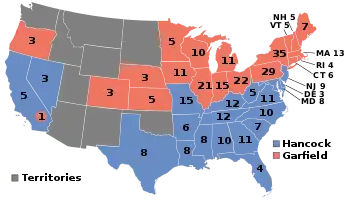1880 United States elections
The 1880 United States elections occurred during the Third Party System, and elected the members of the 47th United States Congress. Republicans retained the Presidency and took control of the House. An unclear partisan situation prevailed in the Senate. As the first presidential election after the end of Reconstruction, this election saw the first occurrence of the Democratic Party sweeping the Southern United States; the party would carry an overwhelming majority of Southern states well into the 20th century.
| Presidential election year | |
| Election day | November 2 |
|---|---|
| Incumbent president | Rutherford B. Hayes (Republican) |
| Next Congress | 47th |
| Presidential election | |
| Partisan control | Republican hold |
| Popular vote margin | Republican +0.1% |
| Electoral vote | |
| James A. Garfield (R) | 214 |
| Winfield Scott Hancock (D) | 155 |
 | |
| 1880 presidential election results. Red denotes states won by Garfield, blue denotes states won by Hancock. Numbers indicate the electoral votes won by each candidate. | |
| Senate elections | |
| Overall control | Republican gain[1] |
| Seats contested | 25 of 76 seats[2] |
| Net seat change | Republican +5[3] |
| House elections | |
| Overall control | Republican gain |
| Seats contested | All 293 voting members |
| Net seat change | Republican +19[3] |
 | |
| 1880 House of Representatives election results on election day. (The results in the black-majority SC-5 and MS-6 were contested and later awarded to Robert Smalls and John R. Lynch by the Republican-majority House.[4])
Democratic seat | |
In the Presidential election, Republican Representative James Garfield from Ohio defeated Democratic General Winfield Hancock.[5] Though Garfield won a clear majority of electoral votes, he won the popular vote by the smallest margin in history. Incumbent one-term Republican President Rutherford B. Hayes declined to seek re-election. Garfield emerged as the dark horse Republican nominee following the 1880 Republican National Convention, prevailing on the 36th ballot over former President Ulysses S. Grant, Maine Senator James G. Blaine, and Ohio Senator John Sherman. Hancock took the nomination at the 1880 Democratic National Convention on the second ballot, defeating Delaware Senator Thomas F. Bayard and several other candidates. Garfield was the first sitting member of Congress to be elected president, and remains the only sitting member of the House to win a presidential election.
Republicans picked up several seats in the House, taking a majority of the chamber for the first time since the 1874 elections.[6]
In the Senate, Republicans made small gains at the expense of the Democrats, but neither party had a majority due to the presence of an independent Senator and a Readjuster Senator.[7] The two parties ultimately agreed to share power.[8]
See also
References
- Republicans gained a majority after the Senate elections, but lost it in September 1881 when Vice President Chester A. Arthur assumed the presidency. The two major parties shared power in the Senate for the remainder of the 47th Congress.
- Not counting special elections.
- Congressional seat gain figures only reflect the results of the regularly-scheduled elections, and do not take special elections into account, or elections later contested.
- "Fifteenth Amendment in Flesh and Blood: Elections".
- "1880 Presidential Election". The American Presidency Project. Retrieved 25 June 2014.
- "Party Divisions of the House of Representatives". United States House of Representatives. Retrieved 25 June 2014.
- "Party Division in the Senate, 1789-Present". United States Senate. Retrieved 25 June 2014.
- "The Great Senate Deadlock of 1881". Senate.gov. US Senate. Retrieved 1 July 2014.